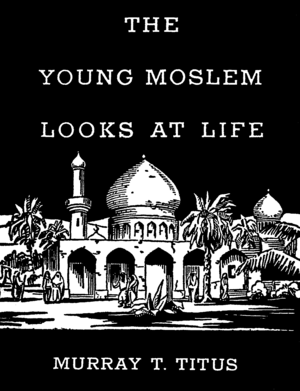The Young Moslem Looks at Life
MURRAY T. TITUS, D.D., Ph.D., has since 1910 been a missionary to the Moslem peoples of North India. He has received degrees from Ohio Wesleyan University and the Hartford Seminary Foundation, and has studied at the University of Chicago. Upon the completion of his college course he was sent to India under the auspices of the Board of Foreign Missions of the Methodist Episcopal Church, and during the first three years of his service there taught philosophy in Reid (now Lucknow) Christian College. In 1916 he was made a district superintendent in the North India Conference, a position which he still holds. In 1932–33 he was convener of the Committee on Work among Moslems of the National Christian Council of India, Burma and Ceylon, and in 1935 he was one of the Council's representatives at the meeting of the International Missionary Council at Northfield, Massachusetts. Dr. Titus is an associate editor of The Moslem World and is a frequent contributor to that quarterly. He is co-editor of the Religious Quest of India series, to which he has contributed Indian Islam, a volume published in 1930 by the Oxford University Press.
Copyright, 1937, BY G. Q. LeSourd
Printed in the United States of America
TO
THE CHRISTIAN YOUNG PEOPLE
OF THE WEST
| CONTENTS | ||
| PREFACE | ix | |
| I. | IN THE WAY OF ALLAH | 1 |
| II. | THE LAST OF THE PROPHETS | 23 |
| Arabia in Mohammed's Time.—Early Life of Mohammed.—Mohammed's Revelations from Allah.—Mohammed's Early Preaching.—Mohammed as Prophet-King.—The Spread of Islam.—"The Greatest of the Prophets." | ||
| III. | THE PERFECT RELIGION | 40 |
| Why the "Perfect Religion"?—The Creed of Islam.—The Moslem's Articles of Faith.—The Sects of Islam.—The Dervish Orders.—Bahaism. | ||
| IV. | THE STRAIGHT PATH | 64 |
| The Ritual of Islam.—The Five Duties of a Moslem.—Rewards and Punishments. | ||
| V. | HOME AND THE FAMILY | 85 |
| Challenging the Purdah System.—Marriage in Islam.—Divorce.—Religious Education of Children.—Celebration of Holy Days.—Amusements. | ||
| VI. | POLITICS AND RELIGION | 104 |
| Three Points of View on Islamic Reform.—Islam as a Political Power.—Holy War.—The Wane of Islamic Political Power.—Moslem Brotherhood.—The Moslem Missionary.—Moslem Religious Intolerance.—Religious Regulation of Public Questions. | | |
| VII. | THE YOUNG MOSLEM LOOKS AT CHRISTIANITY | 128 |
| Moslem Misconceptions of Christianity.—Moslem Appreciation of Jesus.—The Christian Contribution to Moslem Lives.—Heroic Converts to Christianity. | ||
| VIII. | ISLAM CHALLENGES THE WORLD | 148 |
| The Ahmadiya Movement.—Abdul Hamid and Pan-Islamism.—The Challenge of Need.—The Opportunity for Medical Missions.—The Open Door of Education.—The Young Moslem Looks at Religion.—The Challenge to Christianity. | ||
| GLOSSARY | 172 | |
| READING LIST | 175 | |
| INDEX | 179 | |
![]()
This work is in the public domain in the United States because it was legally published within the United States (or the United Nations Headquarters in New York subject to Section 7 of the United States Headquarters Agreement) before 1964, and copyright was not renewed.
- For Class A renewal records (books only) published between 1923 and 1963, check the Stanford University Copyright Renewal Database.
- For other renewal records of publications between 1922–1950, see the University of Pennsylvania copyright records.
- For all records since 1978, search the U.S. Copyright Office records.
Works published in 1937 could have had their copyright renewed in 1964 or 1965, i.e. between January 1st of the 27th year after publication or registration and December 31st of the 28th year. As this work's copyright was not renewed, it entered the public domain on January 1st, 1966.
The longest-living author of this work died in 1964, so this work is in the public domain in countries and areas where the copyright term is the author's life plus 60 years or less. This work may be in the public domain in countries and areas with longer native copyright terms that apply the rule of the shorter term to foreign works.
It is imperative that contributors ascertain that there is no evidence of a copyright renewal before using this license. Failure to do so will result in the deletion of the work as a copyright violation.
![]()
Public domainPublic domainfalsefalse


